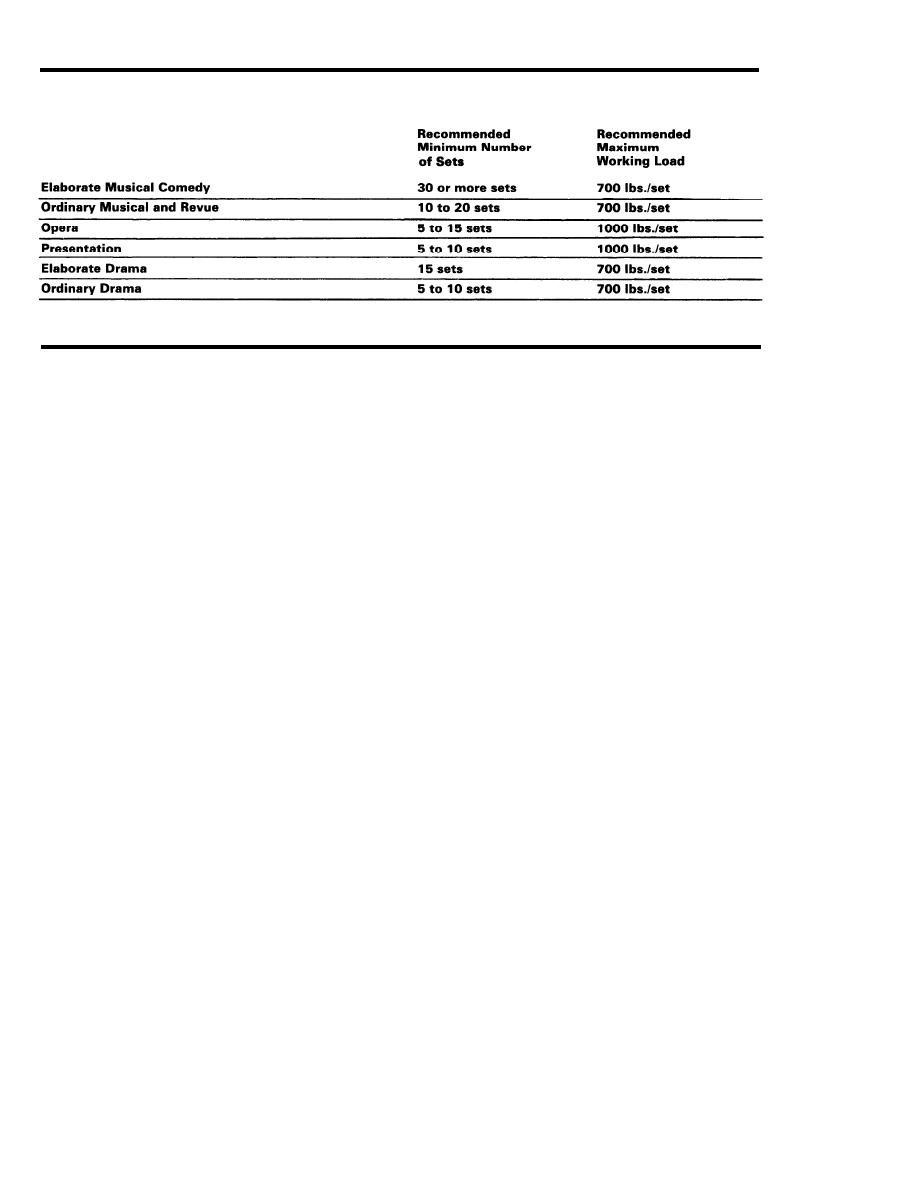
DG 1110.3.120
DESIGN GUIDE: MUSIC AND DRAMA CENTERS
JANUARY 1981
CHAPTER 4: RIGGING AND STAGE MECHANISMS
TYPICAL LINE SETS NEEDED
T A B L E 4-3.1
by placing the tension block at fly gallery ele-
collected at a head block with multiple sheaves
vation-a complicated, expensive, and incon-
and then pass downward. Each set is trimmed
to equalize tension according to the load, and
venient arrangement.
hoisted as a unit. Battens are loaded with a gross
There are three kinds of carriage guide systems.
weight of 30 pounds per linear foot and usually
The least costly is the wire guide, two tensioned
extend 3 to 5 feet past the proscenium opening.
cables engaged by the carriage. Since there are
Rope lines are tied off on a pinrail, which is the
no wall anchors, the sets can be moved up and
onstage edge of the fly gallery from which the
downstage. Carriage sway requires they be
flies are operated. Each line may be sandbagged
spaced approximately a foot apart to avoid foul-
to adjust tension. The fly gallery keeps this ac-
ing. The maximum height of wire guide systems
tivity away from the stage floor, where space is
is 30 feet.
highly-valued. The gallery's elevation is usually
set by the tallest piece of standing scenery and
the ability to see into the flies-that is, 20 to 30
T-Track guides are steel or aluminum rails stand-
feet above the floor, and at least as high as the
ing out from the wall, each engaged by two car-
proscenium opening.
riages. The resultant close grouping of sets pro-
vides the maximum number of available sets per
Wire line sets are counterweight sets. After
linear depth of stage, but where only a few sets
passing over the head block, the lines are fas-
are installed in a group, their effective gridiron
tened by chains and turnbuckles to a counter-
coverage is limited by the divergent angle of
weight carriage. The turnbuckles enable the set
lines passing over the head blocks. Lattice tracks
to be trimmed. The carriage runs up and down,
for single carriages consist of two guide rails
usually at the wall, travelling a distance equal to
separated by ladder-like rungs. They are useful
that travelled by the flown pipe. The weights are
for isolated sets such as house curtains or fire
pig-iron, added incrementally until the set is
curtains.
counterbalanced to a degree that permits man-
ual operation by pulling on a manila purchase
Winch systems are based on a somewhat dif-
line attached to the top of the carriage, running
ferent organizational logic. The gridiron line set
over the headblock, down through a rope lock
concept assumes that most flown material is ar-
to a tension block at the floor and up again to
ranged in parallel planes behind the proscenium.
the carriage. The lines are operated from the fly
However, there are situations in which randomly
located lines are of great value; for instance, for
gallery or from stage floor, but the weights are
diagonal drops and flown orchestra shells and
stored and added at a loading gallery at the top
of the carriage run, level with the carriage bottom
reflectors. The winch lines can be used in com-
to minimize lifting. Dimensional difficulties in the
bination with conventional sets by locating the
design of counterweight systems usually require
loft blocks above the gridiron, underslung from
provision of a counterweight pit in the stage
the roof structure. Each line is taken up on a
floor to increase carriage travel. If it is absolutely
rotating drum driven by a speed-controlled syn-
chronous motor. Controls can be located any-
essential that the floor be kept clear (e.g., for the
movement of scene wagons) a combination of
where and there are no weight guides, lines,
pulleys can reduce carriage travel to half the fly,
sandbags or pinrails to deal with. However,
4-10


 Previous Page
Previous Page
